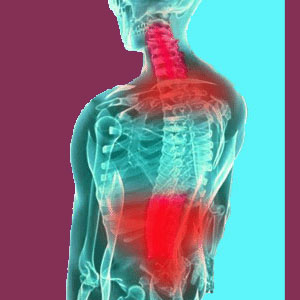
Cervicothoracolumbar scoliosis exists in all three of the major spinal regions simultaneously, including the neck, upper/middle back and lower back. Of all the various types of scoliosis, this particular form has the potential to affect virtually the entire length of the spinal column and therefore create potential symptoms throughout the entire extent of the human anatomy.
Cervicothoracolumbar curvatures are the longest in the spinal column, often ranging for many levels from the neck to the lower back. While these curvatures are long, they are often less severe in terms of degree of curvature, since the curve is spread across so many vertebral levels, but this is certainly not an absolute rule by any means.
This article investigates the facts of side-to-side cervicothoracolumbar spinal curvatures in the human vertebral column. If you are one of the people affected by this most interesting form of scoliosis, this essay provides information you will need to know to navigate the diagnostic and treatment sectors successfully.
Cervicothoracolumbar Scoliosis Characteristics
Cervicothoracolumbar type scoliosis spans the 3 major regions of the vertebral column, including the neck, upper/middle back and lower back zones. These curvatures are the longest of all possible scoliosis formations in the human spine.
Virtually all cases of cervicothoracolumbar curvature follow a multiple S curve shape and often change the lordosis of the lumbar spine, the kyphosis of the thoracic spine and the lordosis of the cervical spine. Vertebral rotation is commonplace and might distort the spine in ways that can only be effectively imaged from the sagittal viewpoint.
Since the length of the curvatures in cervicothoracolumbar profiles are the longest, they have virtually limitless potential for growth and progression. However, most patients stabilize naturally and will not require surgical intervention to halt progression of the curve using spondylodesis techniques.
Cervicothoracolumbar Spinal Curvature Patterns
Cervicothoracolumbar curvatures are often caused by congenital or early developed structural modification of the vertebral column. Few cases are developed by adults as a result of injury, trauma or surgery, although some cases do exist in the medical record.
Cervicothoracolumbar curvatures require the most aggressive braces available and many young patients complain at the level of interference they experience in life from these devices. However, bracing is usually effectual and halts the progression of the curvature, as long as the orthotic is well designed, as well as used as indicated and in full compliance with the physician’s orders.
When invasive treatment is necessary, these very long curvatures often respond very well to scoliosis surgery, since they can be reinforced over many levels and really brought back towards textbook normal. However, the downside is that the fusion must also be used over many levels, escalating its collateral negative effects throughout the spine and limiting physical functionality to a great degree, while simultaneously increasing susceptibility to injury.
Cervicothoracolumbar Scoliosis in Review
Scoliosis which spans the neck, upper/middle back and lower back regions is more common than cervical scoliosis and cervicothoracic scoliosis. However, the condition is less common than the most often observed varieties of thoracolumbar scoliosis and contained thoracic scoliosis.
Most cervicothoracolumbar patients develop their curvatures very early in life, with some enduring congenital development or predisposition and others beginning to show signs of scoliosis during their infancy or childhood. A large percentage begins to demonstrate atypical curvature during the growth spurt of adolescence, while those who express curvatures younger typically escalate in degree of curvature during their preteen and teenage years.
As with all other types of curvature, patients are strongly advised to seek expert diagnostic evaluation and treatment from an orthopedic specialist in atypical curvatures for best outcomes.
Scoliosis > Side to Side Spinal Curvature > Cervicothoracolumbar Scoliosis





